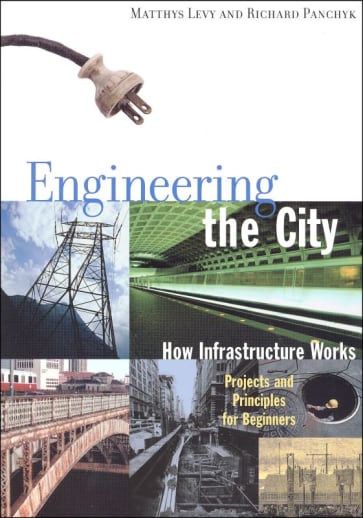How would you like to live in a house that faced a dirt (or mud) road, had no electricity, and where it was commonplace to throw your sewage and garbage out of the window and into the street? Ewww to most of us, that's disgusting, but if you lived in Paris or London hundreds of years ago, you and your neighbors would think this was pretty normal. We, on the other hand can almost take our comforts of life for granted, thanks to the intricate network of infrastructure that brings us fresh water, takes away waste water, gives us roads to drive on, and brings electricity to our homes. This fascinating book takes a look back through history at how each of these infrastructural components evolved, and how they are utilized today in cities and towns. Along the way, activities are included so students can see for themselves the scientific principles and properties that allow these systems to work and serve so many people. In ten chapters, readers will learn about water and its availability, water transportation, irrigation, roads, railroads, bridges, electrical and phone lines, water sanitation, garbage collection, and pollution. For example, in the chapter on water, students will learn about the different methods people have used to bring water to our homes, including wells, aqueducts, water towers, and water pipes. The experiments in this section include: finding a centerline to see how difficult it was for early engineers to build straight tunnels; seeing how water pressure shapes conduits, and discovering how a siphon works. Additional extension activities are include researching where your own water comes from, comparing our water systems with the workings of the human body and drawing a timeline to see the development of water availability systems. For anyone who's ever been curious about what a city looks like underground, or who's wondered where the water goes after it is sucked down the drain, this book offers some fascinating answers. - Jess
Engineering the City: How Infrastructure Works
SKU
029200
ISBN
9781556524196
Grade 4-AD
These icons are designed to help you quickly understand and learn important information about our products.
Teaching Method
Traditional
Teacher-centered curriculum commonly used in classrooms that may include a text, teacher manual, tests, etc.
Charlotte Mason
A methodology based on the work of a 19th century educator who maintained that children learn best from literature (Living Books), not textbooks.
Classical
A methodology based on the Latin Trivium (three stages of learning), including the grammar stage (memorization and facts), logic stage (critical thinking), and rhetoric stage (developing/defending ideas).
Unit Study
A thematic or topical approach centered around one topic that integrates multiple subject areas.
Montessori (Discovery)
A methodology based on the work of a 20th century educator that emphasizes student and sensory-driven discovery learning and real-life applications.
Other
Other methodologies
Religious Content
Secular
Contains content contrary to common Christian beliefs (i.e. evolution).
Neutral
Avoids religious or theoretical topics or presents multiple viewpoints without preference.
Christian/Religious
Faith-based or including instructional religious content.
Learning Modality
Auditory
Learns through listening, talking out loud or reading out loud.
Visual
Learns through seeing, prefers written instructions and visual materials.
Kinesthetic/Tactile (Hands-On)
Learns through moving, doing and touching.
Multi-Sensory
Curriculum that employ a variety of activities/components.
Presentation
Sequential
Curriculum progresses through well-defined learning objectives. Emphasizes mastery before moving to the next topic.
Spiral
Topics and concepts are repeated from level to level, adding more depth at each pass and connecting with review.
Conceptual/Topical
Focus is on the “why,” often with a unifying concept as well as specific skills; coverage may be broader.
Teacher Involvement
Low Teacher Involvement
Student-led materials; parent acts as a facilitator.
Medium Teacher Involvement
A mix of teacher-led time and independent student work.
High Teacher Involvement
Teacher-led lessons; may utilize discussions, hands-on activities and working together.
Additional Materials Required
No other materials needed
Everything you need is included.
Other Materials Required
There are additional required resources that are a separate purchase.
Other Materials Optional
There are additional resources mentioned or recommended but are not absolutely necessary.
Consumable
Consumable
Designed to be written in; not reusable.
Non-Consumable
Not designed to be written in; reusable.
Our Price
$14.95 $14.95 $12.50
Rainbow Savings: $2.45
Description
Details
| Product Format: | Softcover Book |
|---|---|
| Grades: | 4-AD |
| Brand: | Chicago Review Press |
| Author: | Matthys Levy/Richard Panchyk |
| ISBN: | 9781556524196 |
| Length in Inches: | 10 |
| Width in Inches: | 7 |
| Height in Inches: | 0.5 |
| Weight in Pounds: | 0.7 |
| Ages: | 9+ |
| Edition: | Illustrated |
| Pages: | 144 |
| Publication Date: | 10/1/2000 |
Videos
Reviews

